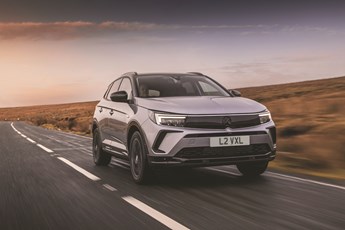
The start point for the best source of fleet information |
First drive: Vauxhall Grandland
Date: 13 April 2022 | Author: Sean Keywood

|
|
||||||||||||||||||||
Surveying the new car market in 2022, it's hard to find a more competitive segment than family SUVs. And for good reason - as Vauxhall representatives pointed out at the UK launch of the model tested here, the facelifted Grandland, it's now the most popular segment among this country's new car buyers. Small wonder therefore that four years after Vauxhall properly entered the segment with this model, it has considered a conspicuous facelift necessary to keep it competitive.
Aside from the slight rebranding - the model was formerly known as the Grandland X - the most obvious change with the facelift is the introduction of the 'Vauxhall Visor' front end, as previously seen with the new Mokka and Astra. It's a bold design element, and although opinions on styling will always be subjective, we'd be surprised if most people didn't consider it a big improvement over the slightly dowdy pre-facelift version.
Inside, the big news is the arrival of Vauxhall's 'Pure Panel' screen arrangement, with a digital instrument display alongside an infotainment touchscreen. From the mid-range GS Line equipment grade tested here, these measure 12in and 10in respectively. The instrument panel is an attractive and useful feature that provides well laid out displays of crucial information such as speed, satnav instructions and hybrid drive info. However, the infotainment screen is less visually impressive, as although it is bigger than the pre-facelift version, in practice it doesn't seem as big as you'd think due to thick black borders either side of the main display area, containing information such as air conditioning temperatures. This does allow you to adjust the cabin temperature via the screen, but this is a strange duplication, as further down the dashboard conventional physical heating controls are also provided. The screen is at least usefully responsive and straightforward to use.
The standard of cabin materials is generally good, though the environment feels gloomy overall, and perceived switchgear quality is no better than average. Our test car also had an interior rattle we couldn't trace during our drive.
Rear seat legroom is reasonable and headroom good, while the boot measures an impressive 514 litres with a petrol or diesel engine, and a less impressive 390 litres with a plug-in hybrid battery in place.
Speaking of engines, those available with the updated Grandland are familiar from the pre-facelift range. These include 130hp petrol and diesel units, and the version tested here, the 225hp plug-in hybrid, with the associated official CO2 and fuel savings that will be of great interest to the fleet market. It pairs a 180hp petrol engine with a 110hp electric motor, while a 13.2kWh battery allows an electric driving range of up to 39 miles under official WLTP testing. The electric motor provides a decent amount of shove, and fairly brisk acceleration is possible in EV-only mode even up to motorway speeds. With both power sources engaged the 225hp available is plenty, and the car has no trouble coordinating the various powertrain elements and eight-speed automatic gearbox.
Unfortunately, the PHEV powertrain does also bring drawbacks due to the extra weight associated with the electric motor and battery. It's more than 350kg heavier than a petrol Grandland, and this shows in a couple of areas.
Road surface imperfections introduce a degree of choppiness to the ride, although larger bumps are coped with well, and while the car corners reliably enough there is a degree of body roll. Unrelated to weight, there's also a fair bit of wind noise at speed.
Aside from the aforementioned and expected BIK and fuel advantages, the PHEV Grandland also looks attractively priced, coming in cheaper on P11D than equivalent rivals such as the Ford Kuga, Volkswagen Tiguan, and Peugeot 3008. Yet despite this very competitive price, lower predicted residual values for the Vauxhall mean that both the Ford and Volkswagen narrowly beat it on a cost-per-mile basis.
Vauxhall Grandland GS Line Plug-in Hybrid-E 1.6 Turbo 225
P11D: £33,765
Residual value: 41.1%
Depreciation: £19,864
Fuel: £2,148
Service, maintenance and repair: £2,492
Cost per mile: 40.84p
Fuel consumption: 192mpg
CO2 (BIK %): 31g/km (12%)
BIK 20/40% a month: £68/£135
Luggage capacity: 390 litres
Engine size/power: 1,598cc/180hp petrol engine plus 110hp electric motor
Verdict |
7/10 |
|||
 |
|
 |
|
|










